MY HISTORY
431 NORTH 38TH AVENUE
The Life and Times of an Omaha Historic Home
6
PART I INTRODUCTION 10
PART II: 1911-1928
RIDING IN HIGH STYLE: THE EARLY COPLEY YEARS 20
PART III: 1928-1949
CONTINUING THE LEGACY: EARL BURKET AND HARRIET (COPLEY) BURKET ERA 26
PART IV: 1949-1967 BEGINNING OF THE CATHEDRAL ROOTS: LAWRENCE TIERNEY THE ATTORNEY 32
PART V: 1967-1984 MIDTOWN LOOKING FOR AN IDENTITY: THE WULFFS 36
PART VI : 1984-1987
SHORT-TERMERS: JAMES FROST AND MICHELLE (MIKKI) WHEELER FROST 38
PART VII: 1987-2021
MIDTOWN RENAISSANCE BEGINS: JOE ZABOROWSKI AND MARY WENDL 66
PART VIII: 2021THE FUTURE: KATRINKA (KOCOUREK) AND TAYLOR STAYTON
5
PART I INTRODUCTION •
This is the story of my last 110 years on 38th Avenue.
I’ve been more than just a house for multiple generations, I’ve been a home. A home is a place to feel safe from the outside world with family and friends.
Over the years, I’ve seen births, deaths, weddings; heard the laughter and cries of children. I have also celebrated anniversaries, birthdays, job promotions and many of the life achievements of those who lived here.
As always in life there is good and bad. Along with the good I’ve witnessed job losses, marital spats, a divorce and the usual parent/child fights. I even narrowly survived the tornado of 1913, which at the time, was mentioned nationally in the same breath as the Chicago fire and San Francisco earthquake.
6
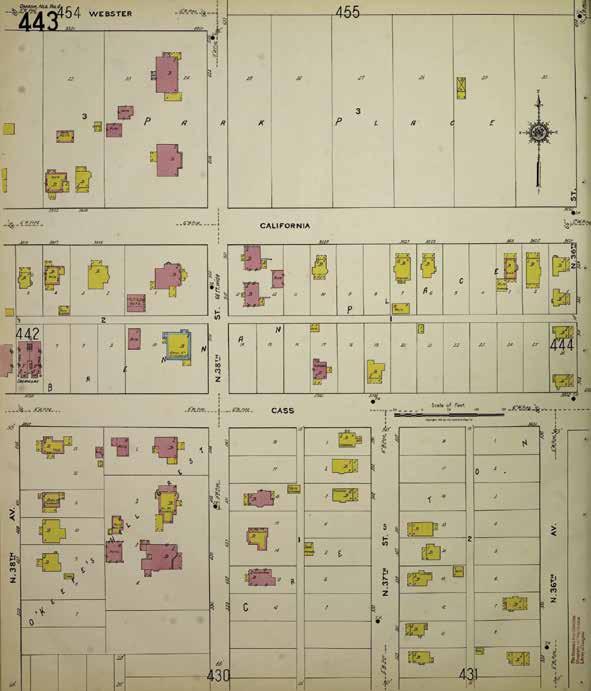
7
1918 Sanborn fire insurance map.
So let me continue my story with a little bit of the area’s history. As the City of Omaha grew westward, the neighborhood including the bordering streets of Turner Boulevard, Park Avenue and 39th Street were known as “West Farnam.” People living in the area used the term with pride just as someone from New York City would reply with panache that they lived on “Park Avenue” or “Fifth Avenue.”
Mansions sprung up throughout the area. Some of the owners’ names included the Omaha elite. This list included Offutt, Storz, Yates, Barmettler, Metz, Kountze, Millard, Nash, Cudahy, and Gifford, to name a few. My immediate area, although part of the ‘West Farnam” district, was appropriately named the “The CathedralDuchesne” area. The neighborhood ran from Dodge to Cuming along 38th Street, a few blocks east and west of 38th Street always in the shadows of the Saint Cecilia Cathedral.
By 1912, the year of my completion, the Cathedral was moving along in its construction, and by 1916 services were held there. Some of the names of those living along 38th Street included Fogarty, McDonald, Hoffmann, Swanson, and Smythe. General history is good to know but I’d like to get back to my story.
Before I go any further, the history of the home is not just how the brick and mortar changed throughout the years, but also the stories of the lives of the people living here. I will tell the story as I best remember it.
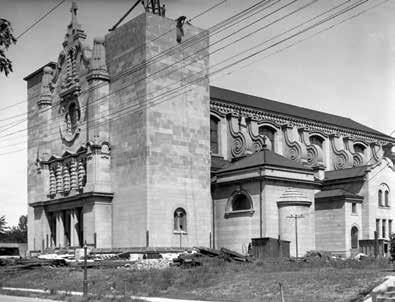
8
1918: Construction nearing completion at Saint Cecilia Cathedral. DURHAM MUSEUM/BOSTWICK-FROHARDT COLLECTION

9
1915: Looking northwest from the roof of the Blackstone Hotel at 36th & Farnam St. Along the horizon line at center is Joslyn Castle at 39th & Davenport St. At right is Saint Cecilia Cathedral at 40th & Burt under construction. DURHAM MUSEUM/BOSTWICK-FROHARDT COLLECTION
PART II: 1911-1928
RIDING IN HIGH STYLE: THE EARLY COPLEY YEARS •
I suppose my birth date is July 12, 1911. That was the day Henry Copley bought the lot from the Porter and Walrath Trust. Henry was an immigrant from England who was born at York in the year 1867. He arrived in the United States in 1874. Henry was a jeweler as well as a watch maker and watch repairman. He made quite a name for himself in the local business community. Copley held major clock repair and maintenance contracts with the Burlington Train Station(s) and the Federal government. This was in addition to his successful jewelry business in downtown Omaha.
10
Henry wedded Pauline Collett in January of 1892. Pauline was the daughter of A.M. Collett (a Union Pacific Railroad Foreman), and Mary Collett, born on February 10, 1872. A.M. immigrated from England, and Mary from Prussia. Pauline was blessed to also have a sister Minnie, and a brother Austin. Before building me, Henry and Pauline had one daughter, Harriet, who was born in September of 1892 by one account, or 1891, another. (So much for government efficiency.)
By the time of my beginnings, the Copleys were well established in the community. Their comings and goings could be followed in the Omaha Bee and The Omaha World-Herald society pages.
Pauline Collett graduation. Omaha World-Herald, June 27, 1890:
My structure was completed in 1912. The year itself was, like most years, filled with news. It had been only nine years since the Wright Brothers defied gravity, we had our first ever parachute jump and the first East-West transcontinental flight completed by Perry Rodgers. Woodrow Wilson had a landslide electoral win over second place Teddy Roosevelt and the Progressive Party. I thought Teddy would win after surviving the assassination attempt but alas I was wrong.
Henry Copley award notice. Omaha World-Herald, April 16, 1903:
Two of my culinary favorites originated in 1912; the addition of toys in cracker jack boxes and Nabisco introducing the Oreo. Perhaps the most memorable event, still talked about today, was the famous Titanic tragedy. There were 1,517 lost souls including one of our own, Emil Brandeis, who resided close by. My completion was certainly pleasant news for the family amid this Omaha tragedy.
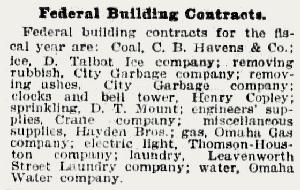
11
An excerpt of a listing of homes damaged by the 1913 Easter Tornado. Omaha World-Herald, March 27, 1913:
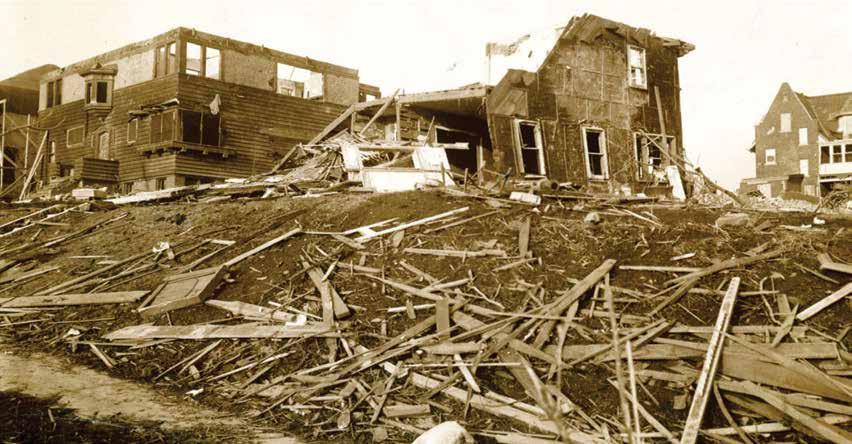
The year 1913 marked my first birthday so to speak. Easter came early in 1913 and it was to be one of Omaha’s darkest days. The Omaha World-Herald reported the day’s events. “March 23 was Easter Sunday, and the day promised spring-like weather. But spring in Nebraska is also tornado season, and the storm which brewed that Easter day proved to be the deadliest in our history. Cass and Saunders Counties were struck first. Thirty-eight people were killed in the towns of Yutan, Mead, Berlin, Rock Bluffs, DeSoto, Nehawka, and Craig. It took the storm only 35 minutes to cover 40 miles of Nebraska. By late afternoon, the storm system was headed for Omaha.
Side of 431 North 38th Avenue, far left.
It was a balmy spring day, with occasional glimpses of the sun and threatening of showers, developing into a heavy downpour of rain. There was little advance warning. Except for a sharp fall of the barometer and temperature; it came and went within a few seconds, giving people scarcely time to get to their cellars.
The tornado hit Omaha at about 5:45 Sunday evening cutting a devastating one quarter mile to one half mile wide swath through the western and northern residential section of Omaha from two to six blocks wide and four and a half miles long.
It came from the southwest crossing the city diagonally striking the most densely populated residential areas, the poorer dwellings in the lowlands, and the most beautiful homes on the hills. The huge, fashionable residences of the denizens of West Farnam Hill suffered alike with the simple cottages of the West Side and the substantial homes of Bemis Park and northern Omaha. The twister turned south, crossing the Missouri River near the Illinois Central Railroad bridge into Council Bluffs. In its wake was left a death list of 103 in the Omaha area alone. It destroyed 800 homes, wrecked another 2,000 homes with a total monetary loss of over $8,700,000 in the metropolis.” ($241,000,000 in today’s dollars.)
Omaha World-Herald, March 24, 1913:
Many of the other homes around me were destroyed or suffered serious damage. I was damaged as well. Recovery for me was easy but for much of the Cathedral-Duchesne area it took years to fully recover. Some of the homes were never rebuilt.
13
One happy note from 1912 is that I was able to see Pauline and Henry’s daughter, Harriet, graduate from Brownell-Talbot. Life continued after Harriet’s graduation. Parties were held, vacations and trips were taken, and Henry and Pauline continued to cement their roles in society and business. Omaha continued to grow with an ever-increasing immigrant population and migration of African Americans coming up from the southern states. The main attraction to laborers were the stockyards, railroads, and the Ford Motor assembly plant on 15th Street. It was built in 1916 just a few years after the first assembly line was introduced by Henry Ford. Retail growth exploded in the downtown. The most
significant event of the decade, overshadowing the world, was set into place in a far-off land on June 28, 1914. Archduke Franz Ferdinand of Austria and his wife, Sophie, were shot to death by a Bosnian Serb nationalist, Gavrilo Princip, during an official visit to the Bosnian capital of Sarajevo. Luckily, so far the United States had been able to stay out of the war.
14
Omaha World-Herald, May 19, 1912:
Omaha World-Herald, March 21, 1917:
1917 was a momentous year for me. Harriet a little while back met a young man, Earl Burket, and set the wedding date after a brief period of courting. Earl Haskell Burket was born in Omaha on October 14, 1888. He was the son of Henry Kennedy and Ella M. (Haskell) Burket. His father was a funeral director until his passing in 1929. Earl graduated from Omaha High School and later attended Colgate University, where he was a member of Delta Kappa Epsilon. He lived in Omaha his entire life. His family business, the H. K. Burket Funeral Chapel, was established in 1876 at Creston, Iowa. The business moved to Omaha where Henry, Earl’s father, grew the enterprise. The business is still going strong. The wedding became one of the main topics everyone was talking about throughout the month of March. The Society Pages in The Omaha World-Herald were filled with information. Whether it be the many bridal parties at the Cotton’s, Miller’s and the DuVal’s, or the bridal rehearsal dinner at the recently completed Blackstone Hotel or the actual wedding itself.
During the 1920s The Blackstone Hotel was one of the premier hotels between Chicago and San Francisco along the Lincoln Highway.
 DURHAM MUSEUM/ BOSTWICK-FROHARDT COLLECTION
DURHAM MUSEUM/ BOSTWICK-FROHARDT COLLECTION
15
Omaha World-Herald, March 18, 1917:
I know the bride is always the center of attention, but I am proud to say I come in a close second. The wedding took place right here on the evening of March 21, 1917. There were 150 guests in attendance. Quite the crowd for me to handle. The opening song “All Joy be Thine” was sung by the young socialite, Alice Duvall. Miss Grace Slabaugh accompanied her on the piano and then followed with the Richard Wagner’s Lohengrin wedding march.
Mrs. Copley soon made her entrance wearing a flesh-colored crepe gown embroidered in pastel shades of bead and trimmed with silver lace. It was made in soft straight lines with long bell-shaped sleeves. The Copley’s left the next day for a threeweek honeymoon in California. This certainly was one of the top highlights of my time here on 38th Avenue.
Omaha World-Herald, March 22, 1917:
16
The war in Europe began having ramifications for the Copley/Burket family. In June of 1917 Earl Burket had to register for the draft. This was in response to the United States entering the war in April. The family had begun a waiting game. Think of the surprise when Earl Burkett, Harriet’s recent husband, was called to serve at the Watervliet Arsenal in New York State. He worked there for six months in the ordnance department returning in December of 1918. Shortly after “the war to end all wars” concluded, life was returning to normal. I felt a bit empty after Earl and Harriet Burket moved a few miles away to begin their married life, one of the inevitable cycles of life.
The 1920s brought a new vibrancy to the country. This decade wasn’t called the Roaring Twenties for no reason. The end of the war saw the formation of the League of Nations and hope was that the world would see the end of devastating wars. A few of the patents to make life simpler were issued including hair dryers and adhesive bandages. Mass media was born with radio which spilled over to athletics and a man name Babe Ruth catapulted the New York Yankees into its place as the most famous sports franchise in history.
Politics in the US was in an uproar. Two controversial amendments were added to the Constitution. The Women’s right to vote and prohibition. The latter was short-lived but gave rise to organized crime and an unknown man named J Edgar Hoover was appointed as the Director of the FBI. He turned the FBI into an unbreakable political force. The Stock Market crashed in October of 1929 and the world economy was thrown into turmoil. The Great Depression was beginning.
Omaha Daily Bee, Dec. 6, 1918:
Omaha World-Herald, Dec. 15, 1918:
17
Omaha saw itself grow. The rise of Hollywood movies contributed to a theater boom in downtown Omaha as well as a new suburban theater in Dundee. Tom Denison’s corrupt political machine ruled the city throughout the decade. The breweries, meat packing houses and the rise of the railroads were an economic force which made the Gold Coast residents wealthier. This made the area around me worthy of its name. Saint Cecilia Cathedral was already celebrating masses and on its way to becoming a landmark.
It was also a time of change and growth for me as a house. The neighborhood was rebuilt after the 1913 tornado, and I was put back on the tax rolls in 1920. The Copley’s were officially empty nesters and they continued to entertain. Copley Burket was born on September 30, 1923, to Harriet and Earl Burket. Henry and Pauline relished their new grandson.
 1926: The Livestock Exchange Building in South Omaha, nestled amongst cattle pens and railroad tracks. DURHAM MUSEUM/BOSTWICK-FROHARDT COLLECTION
1926: The Livestock Exchange Building in South Omaha, nestled amongst cattle pens and railroad tracks. DURHAM MUSEUM/BOSTWICK-FROHARDT COLLECTION
Omaha World-Herald, Nov. 18, 1920: I was able to keep up with local gossip and business affairs of the area. There was one incident that still bothers me until this day. Right before Christmas in 1920 some thieves managed to steal a pass key and burgled Mrs. Copley’s fur capo. In today’s dollars, the capo would be valued at $14,000. It seems these thieves were targeting homes in the area.
Henry became interested in gardening and began landscaping and planting including the 100-foot white pine, in the back yard. The white pine still stands over me today. He retired from his jewelry and clock business in 1922. Life at 38th Avenue was grand.
Then on March 28, 1925 Henry died suddenly while working in the garden. His death was unexpected, despite being what can only be described as good health, he succumbed to a stroke. He died within minutes before Pauline could get to him. Private services were led by Rev. Thomas Casady, rector of All Saints Church on Tuesday, March 31 with internment at Forest Lawn.
Life was about to change for me. As with all changes some are for the good and some offer challenges.
Omaha World-Herald, March 3, 1925:
19
PART III: 1928-1949
CONTINUING THE LEGACY: EARL BURKET AND HARRIET (COPLEY) BURKET ERA •
After Henry’s death, their daughter, Harriet, along with her husband, Earl, and son Copley, moved back to 38th Avenue. They also brought along a housekeeper named Sylvia Hultquist and they were settled in by 1928. The social life of the house picked up considerably at this time and the country was looking forward to the next decade.
However, the 1930s saw a dark cloud forming across the world with the rise of Fascism, Communism and continued economic downturn from the Great Depression. The United States had a new president who went by the initials “FDR” and was bringing some new hope to the country. He went to work immediately and began a massive restructuring of the economy to help boost the country out of the Great Depression.
20
Omaha continued to see the previously mentioned population trend continue and held its own economically during the decade. Times were tough but Omaha seemed to be weathering the fiscal downturn. The Omaha Stockyards and breweries added to economic recovery. The Joslyn Art Museum was built, and the Omaha Star began publication as the state’s first black owned and operated newspaper.

As the Copleys before them, the Burkets established themselves in Omaha society. Although not as prominently as the Copleys, they were mentioned often in the society pages. The Burkets did enjoy traveling as a family together and did so as often as possible. Earl was drawn to boating and liked to race and participated in national competitions as early as 1929. Earl’s love of boating led to his involvement in the Sea Scouts, a branch of the Boy Scouts, where he became an adult leader for over two decades.
World-Herald, Aug. 12, 1929:
Omaha
21
The Joslyn Art Museum opened in 1931. DURHAM MUSEUM/BOSTWICK-FROHARDT COLLECTION
22
Omaha World-Herald, Oct. 10, 1931:
Copley Burket was also making a bit of a splash for himself in Omaha society. As early as the age of eight he was named to the Aksarben Court in 1931 and took part in the coronation. Copley also seemed to have the boating bug in his veins and became part of the Sea Scouts. In February of 1938 he was honored for becoming an Eagle Scout. Copley was often named to the Honor Roll at Central High School and in the Fall of 1940, he started his senior year. Both Copley and his parents were enjoying their time in the house and the neighborhood.
In general, I was well taken care of by the family. Holidays were grand and guests were entertained quite frequently. There were just cosmetic changes made to the house. The one I enjoyed the most was replacing the ice box with a real refrigerator a few years ago. The family was noted for keeping up with the modern household conveniences. The landscaping done by Henry Copley was maintained but not overly expanded. The block I live on made a complete recovery from the tornado and a canopy of new trees covered the block. There was still an empty lot to my north, but other lots were filling in. Both the 417 and 411 addresses now had homes on them that were completed a decade ago. Only the two lots on 38th Avenue and Chicago remained vacant.
Earl Haskell Burket was born in Omaha, Neb., Oct. 14, 1888, son of Henry Kennedy and Ella M. (Haskell) Burket. His father, who was a funeral director, was born in Grand Detour, Ill., Oct. 24, 1850, and died in Omaha, Dec. 27, 1922. His mother was born in Tiskilwa, Ill., Feb. 26, 1854, and died in Omaha, July 22, 1929.
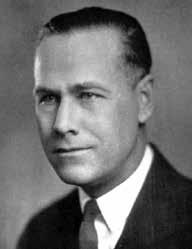
Mr. Burket was graduated from Omaha High School and later attended Colgate University, where he was a member of Delta Kappa Epsilon. He has lived in Nebraska 42 years. The H. K. Burket Funeral Chapel was established in 1876 in Creston, Ia. In 1883 the family came to Omaha, where Henry K. Burket entered the undertaking business. The business is the oldest established firm in Omaha. Mr. Burket has been connected with the business since June 1914, and is owner of the H. K. Burket and Son Funeral Chapel.
He was married to Harriet Copley in Omaha, March 21, 1917. Mrs. Burket was born in Omaha. They have one son, Copley born Sept. 30, 1923.
Mr. Burket is a member of the Chamber of Commerce, the Rotary Club, and the Pro Tem Coub. He is a Scottish Rite Mason, Knight Templar and member of the Shrine. His clubs are the Omaha Club, the University Club and the Happy Hollow Country Cub. He is a member of the First Baptist Church. His hobby is trees. — Nebraskana, 1938
23
Omaha World-Herald, Jan. 28, 1943:
The decade of the 1940s was dominated by one event both home and abroad. The world had entered another world war which effected all aspects of life. Omaha was certainly not immune to this. The Burkets maintained their place of prominence in the business community. The Burket funeral home was one of the most prosperous in the city. The society pages were not as popular as they once were. Perhaps the Depression and certainly the war effort made the society pages less glamorous than they were earlier in the century. The bright spot at the residence was Copley’s success at Colgate University and the Harvard School of Business. He also served his country during WWII in the naval V-12 program. The Sea Scouts prepared him well for the naval life. It is a program like the ROTC today. There were certainly anxious moments at the house as Copley was off to serve the country. Luckily for him he remained in state as part of the V-12 program.
Omaha World-Herald, July 18, 1945:
From a physical side there were not many changes to the house at the time except for one modification. The builtin bookcases separating the fireplace from the rest of the living room were removed. My scars are still visible today as you look at the ceiling beams, the beams on the wall, and the floorboards.
A bigger change occurred on the morning of July 17, 1945. Pauline Collett Copley passed away quietly here at her home. Services were held at the Burket Funeral Home with internment at the Forest Lawn Cemetery. Pauline had lived here for 33 years. She raised a family, survived a tornado, the Great Depression and saw two great world wars. She certainly was a stalwart to the neighborhood and the community. My fear is with her gone and Copley out of the state, the era of Henry and Pauline Copley will soon be ending. Time will tell if this is true.
24
Omaha World-Herald, June 9, 1969:
Omaha World-Herald, April 15, 1944:
25
PART IV: 1949-1967
BEGINNING OF THE CATHEDRAL ROOTS: LAWRENCE TIERNEY THE ATTORNEY •
As expected, the Burkets, after much contemplation, decided to move out. With Copley moving to the Chicago area in the late 40’s, I was to change hands.
The estate of Pauline Copley went to probate and all encumbrances were settled by May of 1946. The total estate, including the house, if adjusted for inflation would be valued at a little over a million dollars today.
26
I was sold to Lawrence “Turk” Tierney in June of 1949. Tierney was a prominent attorney in Omaha. Turk was born in 1908 and grew up in Omaha. He married Harriet Sillstrop a few years after graduation from Creighton Law School in 1932. Harriet was the daughter of Theodore and Mary Sillstrop and moved to Omaha from Kearney, Nebraska. They had four children; Mary was born in 1937, Sarah 1938, Theodore (Ted) 1940 and Tim in 1947.
The Tierneys brought a new life to the house with the addition of four young children and a mover and a shaker in Lawrence (AKA Turk and Larry), the father of the clan. In his days at Creighton, Turk, as he was known back then, was involved in both athletics and many other organizations at the University. This competitive spirit served him well throughout life. After law school many of his courtroom exploits can be found in the pages of The Omaha WorldHerald. While out of the courtroom, Larry was an avid hunter, golfer and regular on the handball courts.
 Lawrence “Turk” Tierney (back row, fourth from left), Creighton Royal Court 1932.
Lawrence “Turk” Tierney (back row, fourth from left), Creighton Royal Court 1932.
27
Omaha World-Herald, April 17, 1929:
World-Herald, April 29, 1948:
The glory years of the Gold Coast were usually defined as the turn of the century until right before World War II. The time of the Tierneys saw the area blossoming but in a less egalitarian manner. The post-war years saw a booming of the country’s economy into the 1970s. A demographic change in my neighborhood certainly took place. The Cathedral took a more prominent role in the area which was surrounded by large families who came to Saint Cecilia to worship and attend school. In the early 1950s the new grade and high schools were built and were close to overflowing. In 1959, the Cathedral was consecrated with the completion of the bell tower.
The influence of the Cathedral stretched beyond the immediate campus, and one would often see nuns in habits walking in pairs or larger groups on their daily strolls. The streets were filled with students walking to school in the morning and late afternoon. As I look back in history, the Catholic Church was at its peak in this country for the decades following WWII. This rise to prominence was also true for Omaha and my neighborhood.
I was happy to receive several updates and improvements. After the Tierneys moved in the southwest screened porch was enclosed and set up as a home office for Larry’s law practice. The Burkets had previously built the screen-in porch and added the garage. It featured built-in shelves and horsehair insulation. The kitchen was updated into the style one found in the modern late 1950s to early 1960s homes. The area under the upper screened porch was turned into an enclosed all-weather addition with a half bathroom. Plumbing and electric were added to accommodate a washer and dryer.
28
Omaha
The pond was still in use but the white pines surrounding it were becoming out of control. The neighbors were routinely entertained by watching their hunting dog take regular swims. I also was the recipient of the new concept in home décor, known as wall to wall carpeting in the bedrooms. During this time, the coal burning Octopus Furnace the Copleys installed (early 1940s) to provide central heating, was converted to gas. If you look at my lower level, you can see where the windows were installed over the coal chutes. Modern heating was here to stay.
Improvements were always a good thing, but watching a family grow and enjoy the home was more important to me. The children went through Saint Cecilia school system and had notoriety of their own. Ted and Tim did venture off and attended Creighton Prep for High School.

29
Mrs. Lawrence Tierney, third from left, at a May 1954 Cathedral High tea for seniors to honor their mothers.
Both daughters, Mary and Sarah, were quite the thespians at Cathedral High School. Mary even received a rave review in The Omaha World-Herald for her performance in the cathedral senior play “The Old Doc.” Ted became a star athlete in high school and participated in football, basketball and served as class officer. He even managed to have his car stolen outside the home in 1959.

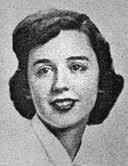
There are a few memorable events that stood out during the Tierney days. Omaha was in the process of changing zoning laws in early 1950. They had just approved a change which made it easier to convert single family houses to multi-family rentals. In June of 1950, using his legal skills, Larry fought the re-zoning in the neighborhood. There was quite the uproar at City Council with Tierney and Hugh Fogarty from 38th Street leading the charge. The city did change zoning which had a negative effect in the neighborhood for decades. It wasn’t until the 1980s that the downward trend began to reverse.
 Mary Tierney (center) in a 1954 Cathedral High Senior play.
Mary Tierney, 1954 Cathedral High School senior picture
Mary Tierney (center) in a 1954 Cathedral High Senior play.
Mary Tierney, 1954 Cathedral High School senior picture
30
Sarah “Therese” Tierney, 1955 Cathedral High School senior picture
Omaha World-Herald, Dec. 20, 1956:
One of those humorous moments one seems to always remember occurred in 1956. The Tierneys were having a Christmas party in December of that year and a couple of teenage boys from high school tried to crash the party. Larry turned them away. In a short time, fire trucks made their way to the house. Someone turned in a false alarm to the fire department saying the furnace blew up. The youths were questioned but no charges were filed.
One of the proudest moments was in 1961 when Ted Tierney’s quick thinking while acting as a lifeguard at Peony Park saved a life. While swimming, Joyce Lynn, disappeared under the water. She was found when another swimmer happened to step on her arm. Ted jumped in and pulled her out and resuscitated her through mouth-to-mouth respiration. She was revived before the rescue squad arrived. Ted was credited with saving her life.
As years passed the cycle of life was playing out in the home. The children were growing up, marrying, and having children of their own. In 1956 Mary Helen, the eldest, married Patrick C. Lemmers. In February of 1966 Sarah, the second daughter, wed John Whiting Gridley of Chicago at the Old Saint Mary Church. I’ve seen this before and realized a new resident would soon be arriving. Ted was engaged to Miss Sheila Jo Crogan of Lincoln and the house was sold to the Wulffs before Ted and Sheila were married in November of 1967. The Wulffs took ownership in March of 1967. Even though the Tierneys were gone, I would be remiss not to mention the marriage of their last son, Tim, on Valentine’s Day in 1969 to Margaret Eleanor Warren of Waukegan, Illinois. The family was scattering across the country. The new owners would soon be moving in.
Omaha World-Herald, June 13, 1961:
31
PART V: 1967 -1984
MIDTOWN LOOKING FOR AN IDENTITY: THE WULFFS •
John and Delores Wulff were the next family to reside here.
They moved from the 30th and Jackson Street area to 38th Avenue.
They paid $25,000 for the home which is $205,000 in today’s dollars.
John spent most of his career at J.P. Cooke Company and Dolores worked at home.
They brought along seven children as well as John’s father, Conrad. Conrad’s health was the main reason the family moved here. They needed more space to care for him in his convalescence.
He took up residence in the former office space of Lawrence Tierney.
32
The area around me was in a bit of a decline. The social upheaval in the nation was not a positive one for the cities across the country. White flight to the suburbs presented many challenges to urban city center cores. Omaha was no different. In fact, the zoning laws enacted led to some of the declines. As Hugh Fogarty put it in his book on local history “the lower half of 38th Avenue had become almost all rental.” The Cathedral was still going strong both as a parish and a school. It continued to be an anchor for the neighborhood. Most of the activities of the Wulff family centered around worship, school, social life and particularly school sports at Saint Cecilia Grade School and Cathedral High School.
The family was exceptionally athletically talented. They were quite the force in the local tennis circuit, and it would not be unusual to see Terry, Gary, Tom, Anne, and John in the local sports pages for their exploits. Tom and Gary were first tier athletes at Cathedral High and between them both participated in football, basketball, and track. I would say the highlight of their many feats was Gary Wulff leading Cathedral High School in tackles as they defeated arch-rival Holy Name back in September of 1971.
Omaha World-Herald, June 16, 1959:
Omaha World-Herald, Sept. 12, 1971:
33
Omaha World-Herald, Aug. 15, 1968:
The house had lots of celebrating with birthdays, Confirmations and graduations. Terry even had her wedding reception here after the ceremony at Cathedral. One incident that rocked the house occurred on August 14, 1968. Terry, who was riding a motorcycle with Robert Schulze, was struck by an automobile. According to police, “they were hurled 50 feet in the air” after impact. Lots of prayers were said for Terry after she was rushed to the County Hospital and was in critical condition with head injuries. In the end she recovered from her injuries.
As for the physical structure of the house, a few things were done. The first was the roof. One day when John was walking across the roof to inspect it, he fell through, and his legs were left dangling in the attic. Since he was not hurt, everyone had a good laugh over that one. This of course necessitated replacing the roof. The white pines were removed around the pond, and it was filled in by the Wulffs. The first cement patio was poured in the back yard for outdoor entertaining and a place to relax for the family. The patio also helped solve the constant problem of the drain at the back of the house going to the front from clogging. The parking area in front was widened. This made perfect sense with the number of children in the house that were at driving age.
Full ownership of the home passed onto Delores in 1980 as part of a divorce settlement. The children had grown up and most of them had already moved out; starting their own lives. The usual pattern I’ve seen throughout the years meant only one thing. New owners would soon be arriving.
Before I go on to the new owners there is still an unsolved mystery. Until a short time ago I found out about a somewhat secret sale. Joe Zaborowski, the current owner, was researching a gap in my abstract and discovered that Delores sold the home to Carolyn Casey, a resident of 38th Street, in 1982 for $61,500. This sum would be equivalent to $173,034 in today’s dollars.
34
The mystery doesn’t end there. Carolyn Casey was acting as the trustee for Carol O. Kuehn, Helen A. Kuehn, and Frederick T. Kuehn. Seems these folks were part of the Kuehn family that owned property in the neighborhood that the patriarch bought after the 1913 tornado. Delores did live there until it was sold to James Frost, and interviews done with neighbors and her children shed no light on this sale. Someday the secret of this sale will perhaps be uncovered.
35
PART VI: 1984-1987
SHORT-TERMERS: JAMES FROST AND MICHELLE (MIKKI) WHEELER FROST •
Delores sold the home in 1984 to James and Mikki Frost who had married earlier that year. The sale price was $51,085. This would be $136,000 in today’s dollars. At the time they both worked as attorneys. James still works as an attorney and currently is employed at McGrath and North. Mikki is now the Director of Human Resources for the City of Omaha. Their time was short at the house and there were some improvements. The floor was sanded and refinished on the main level. They also added a privacy fence to the southwest corner of the patio area next to the small garden spot by the porch. The house went up for sale in the spring of 1987.
36

37
431 North 38th Avenue as it looked in 1987.
PART VII: 1987-2021
MIDTOWN RENAISSANCE BEGINS: JOE ZABOROWSKI AND MARY WENDL •
The new owner, Joe Zaborowski, moved in during the early summer of 1987. I really didn’t know what to think; he was a single guy and the last one didn’t last very long in the house after marrying. He was also a foreigner so to speak. He was born in New Jersey. He made his way here in January of 1977 from the Meadowlands of New Jersey in the shadow of New York City via North Miami, Milwaukee, Des Moines, and a brief stop in St. Louis. He worked in restaurant management since 1975 when he graduated from Marquette University.
38
Joe took in a couple of roommates and there always seemed to be a group of men and women around the house. A different vibe than families with children. I was quite surprised to see the house fill up for the first major holiday, Thanksgiving, after he took ownership of the home. Seems he had a tradition of inviting single people who had nowhere to go for the holiday.
To my surprise, work on upgrading the house began almost immediately. Improvements were sorely needed. One week after moving in there was a heavy rain resulting in water flowing into the east side of the basement. Joe promptly brought in Daedalus Construction to pour a new patio and sidewalk along the north side and a concrete pad to the south of the garage. For some reason he had the concrete workers bring in a collection of street pavers the city was discarding from a project by the downtown mall. More will be revealed on this later.
The spring of 1988 brought some more surprises. I found out he had a bit of a green thumb and was doing some big garden planning. My backyard had not seen much attention since the Henry Copley days. It was a flat piece of grass that featured a fenced in dog run along the east fence at the back of the yard. The only thing growing were some junk trees that sprouted under the power lines. The fence came down and Joe tilled up the dog run to the north fence line. This was the beginning of the rebirth of the backyard. Joe discovered a buried pond and dug it out with the help of John Wazenried, his neighbor on 38th Street and Cass.
Old concrete patio, 1987.

39

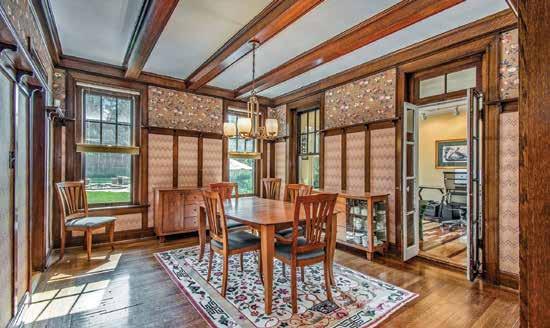
58
Living room
Dining room

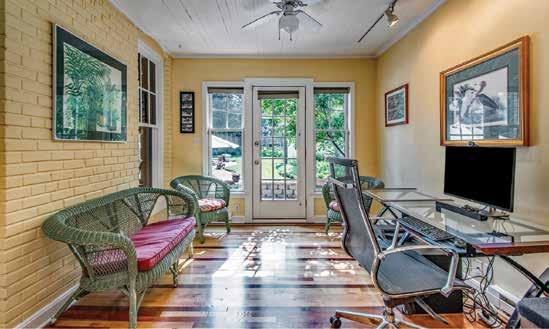
59
Office Computer room


60
Kitchen Kitchen breakfast bar

 Kitchen bathroom
Kitchen bathroom
61
Upstairs bathroom
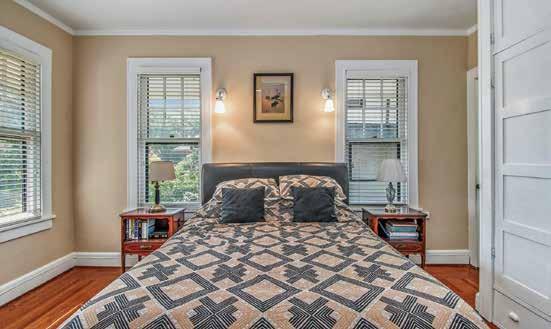
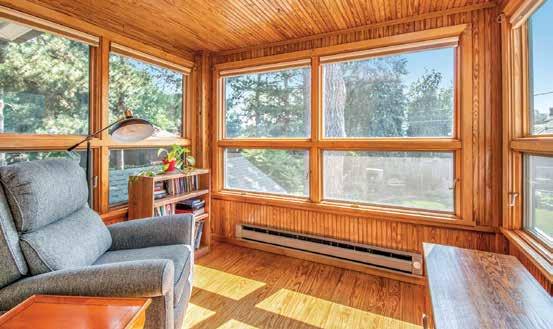
62
Master bedroom
Upstairs bedroom porch
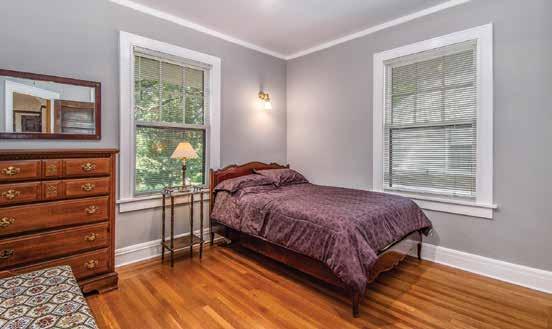
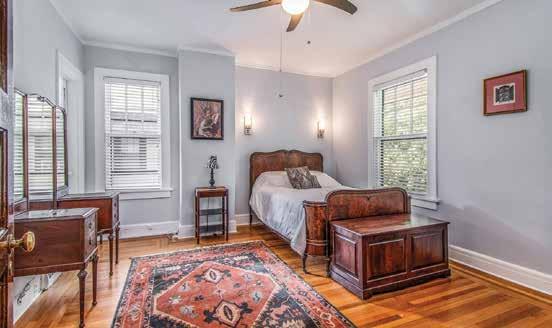 Southwest bedroom
Southwest bedroom
63
Northwest bedroom
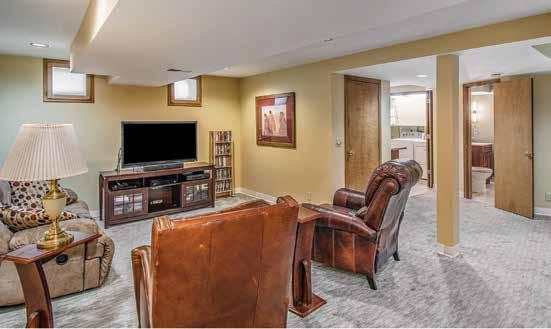

64
Basement family room
Basement family room

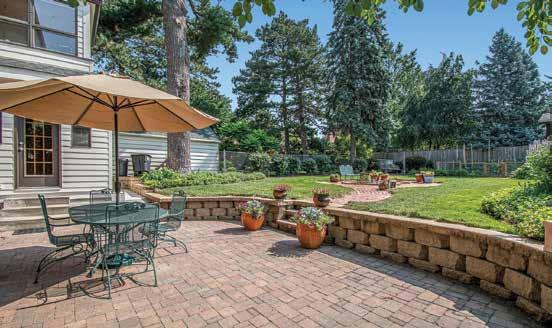 Backyard patio looking east
Backyard patio looking east
65
Downstairs bathroom

68
New and old owners visit on the porch. From left, Mary Wendl, Katrinka Stayton, Taylor Stayton and Joe Zaborowski.
•
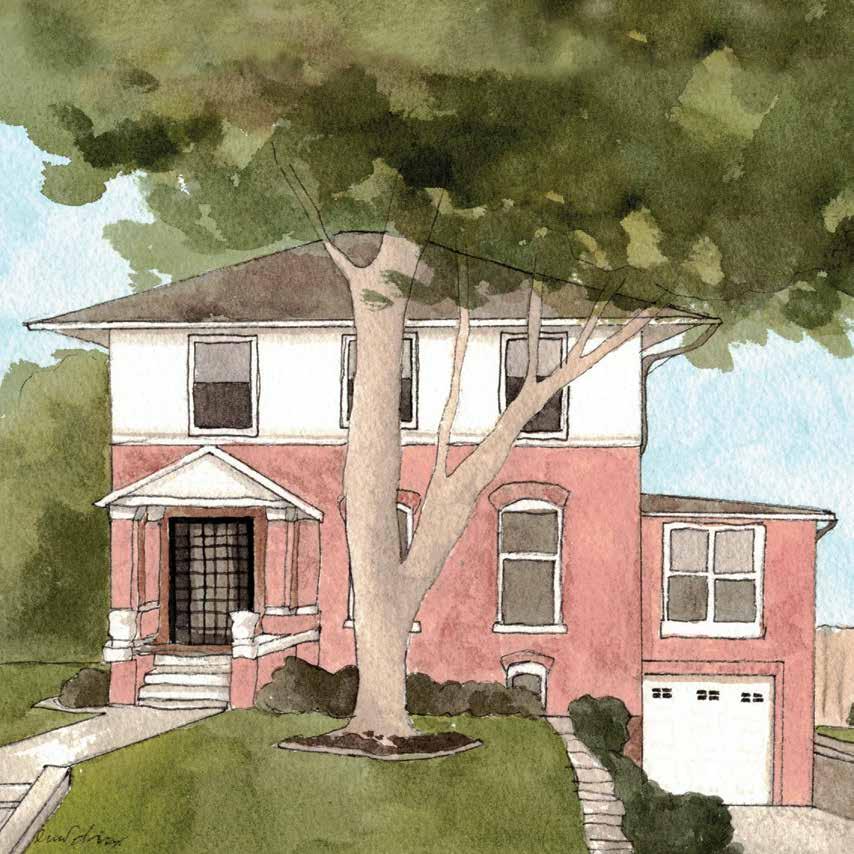






 DURHAM MUSEUM/ BOSTWICK-FROHARDT COLLECTION
DURHAM MUSEUM/ BOSTWICK-FROHARDT COLLECTION
 1926: The Livestock Exchange Building in South Omaha, nestled amongst cattle pens and railroad tracks. DURHAM MUSEUM/BOSTWICK-FROHARDT COLLECTION
1926: The Livestock Exchange Building in South Omaha, nestled amongst cattle pens and railroad tracks. DURHAM MUSEUM/BOSTWICK-FROHARDT COLLECTION


 Lawrence “Turk” Tierney (back row, fourth from left), Creighton Royal Court 1932.
Lawrence “Turk” Tierney (back row, fourth from left), Creighton Royal Court 1932.



 Mary Tierney (center) in a 1954 Cathedral High Senior play.
Mary Tierney, 1954 Cathedral High School senior picture
Mary Tierney (center) in a 1954 Cathedral High Senior play.
Mary Tierney, 1954 Cathedral High School senior picture









 Kitchen bathroom
Kitchen bathroom



 Southwest bedroom
Southwest bedroom



 Backyard patio looking east
Backyard patio looking east
